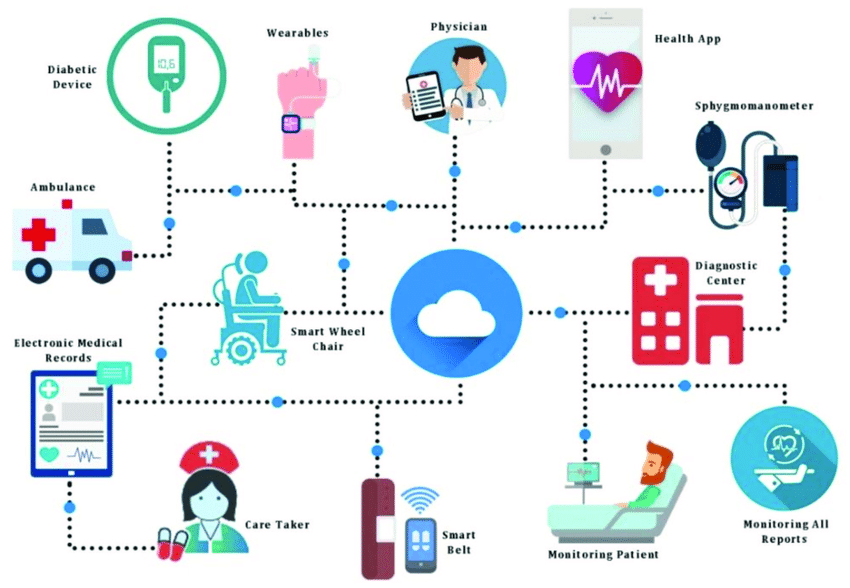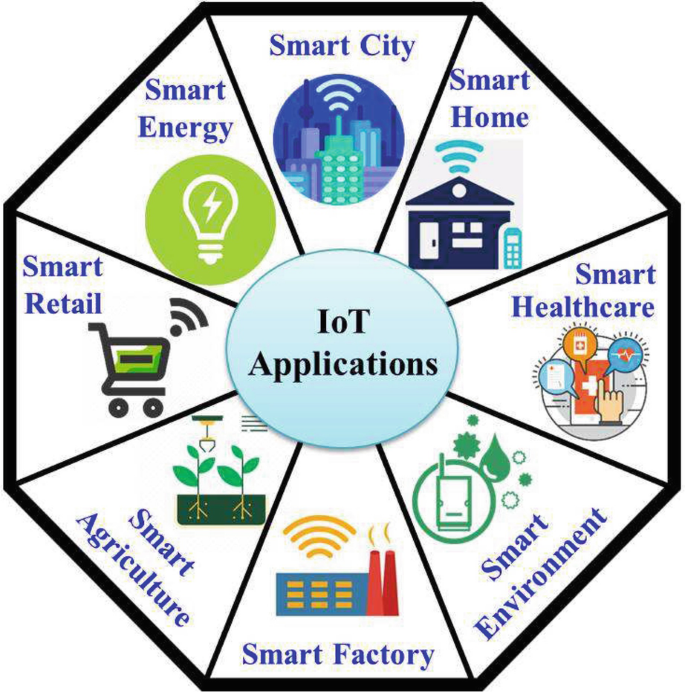the use of the Internet of Things in medicine
What is the use of the Internet of Things in medicine?
What is the Internet of Things in medicine, and what is its application? Why does the healthcare industry also use the Internet of Things technology? What is the advantage and application of this method? If you have such questions in your mind, stay with us until the end of the article to get your answers.
Definition of medical Internet of Things
The concept of the Internet of Things means connecting different objects and devices to each other through the Internet. In fact, this technology enables people to manage and control the things they use remotely with the help of internet infrastructure. Now, if we implement the same work for medical and therapeutic equipment and devices, it is called the Internet of Medical Things (IoMT).
In the 21st century, we saw the development of exciting technologies, including the Internet of Things. Thanks to this technology, the treatment staff can easily and quickly see the patient’s biometric information through the hospital network; But the only use of the Internet of Things is not limited to these and includes the following:
More monitoring of the patient
Before the emergence of the Internet of Things, the interaction between doctors and patients was limited to face-to-face meetings, telephone, or text communications. In this situation, there was no other way for doctors to monitor the condition of patients 24 hours a day. For this reason, the time and energy of the treatment staff was spent only for the purpose of taking care of the patient.
Today, doctor-patient interaction is considered to be the most important application of the Internet of Things in medicine. Doctors can monitor the patient’s health remotely using this technology. Also, the use of this method has a great impact on reducing the costs of human resources and health care and improving the results of patient treatment.
Remote health and monitoring
The future of the Internet of Things in medicine is progressing day by day, and one of its applications is remote patient monitoring. In this situation, patients do not even need to be physically present in the hospital and emergency room. For this reason, Internet of Things experts have designed an application called telehealth, through which doctors can remotely communicate with the patient and monitor his condition.
This work not only minimizes the costs of the doctor and the patient but also helps improve the patient’s quality of life; Because some people are limited in their mobility due to their physical conditions, and it will be very difficult and exhausting for them to go to medical centers every day.
Access to modern hardware
Today, modern hospitals are equipped with highly advanced software and hardware, which are very useful in maintaining the health of patients. These devices, like much other electronic equipment, are susceptible to risks such as power outages, system failures, etc., which can lead to disruptions in the treatment of patients or even their death.
For this reason, IoT experts were able to design a device called e-Alert using an Internet of Things application in medicine. The main use of this device is that it monitors the hardware needed in the hospital and alerts the hospital staff in case of any problems or malfunctions.
Follow-up of staff, patients, and equipment
One application of IoT in medicine is to track employees, patients, and hospital property. Hospitals are usually large medical facilities that are very difficult to control. No matter how strong and clear a mechanism is established to track property and its hardware, a device may still be lost or stolen. This is always easy to do in smaller centers, but controlling hospitals and universities with thousands of patients and staff is very difficult.
Many modern hospitals in the world can easily track property and equipment using Internet of Things systems. In this method, the cost of manpower for supervision and daily activities in the hospital environment is greatly reduced, and the personnel focus on providing services to patients.
Advantages of using the Internet of Things in medicine
The infrastructure of smart hardware, software, health systems and smart medical services, etc., are all part of the medical Internet of Things. All hardware and methods based on IoT technology are generally divided into two categories; That is, the methods that are related to hospitals and doctors and the other methods that are related to patients.
In the following, we review some applications of the Internet of Things in medicine and health:
Reduce treatment costs
One of the most important benefits of the Internet of Things in medicine is that it enables real-time patient monitoring. Therefore, it significantly reduces additional costs for hospital stays, unnecessary visits and readmissions.
Increasing the quality of better treatment
The Internet of Things in medicine enables the treatment staff to make more accurate decisions based on the evidence and the patient’s condition. This can be easily done using the collected and accurate information that this technology gives them.
Faster disease diagnosis
One of the ways to quickly diagnose the disease happens when doctors continuously monitor the patient and its data and information. By using the Internet of Things technology, it is possible to correctly diagnose a person’s illness and also to start taking serious measures based on the symptoms before the illness.
Prevention of disease
In medical science, prevention is always better than cure. Therefore, by constantly monitoring the health of the person, necessary measures can be taken to prevent various diseases.
Medicine and medical equipment management
One of the most important challenges in the healthcare industry is drug and medical equipment management. This challenge can be managed by using IoT technology and through connected devices, which will eventually lead to the reduction of unnecessary costs.
Reduce human error
One of the challenges in the medical field is misdiagnosis and human errors. Misdiagnosis in many industries causes various losses, But because medicine deals with human lives, a wrong decision may cause irreparable damage.
For this reason, doctors can increase the speed and quality of their decision-making by using the data and information created by the Internet of Things devices. Errors and additional care costs are also reduced.
Conclusion
In this article on the Internet of Things in Medicine, we talked about smart devices and systems. This technology will never replace medical care; Rather, they can help to improve services to patients and make the work of hospital personnel easier.
Today, Internet of Things companies are very active in the field of medicine, and today we see the construction and design of many software and hardware that have increased the health level of people in society.
Frequently asked questions
Name some applications of the Internet of Things in medicine?
Reduction of treatment costs, more monitoring of the patient, faster diagnosis of the disease

The difference between artificial intelligence and the Internet of Things
Considering the high dependence of humans on technology, artificial intelligence and the Internet of Things has a very bright future. There are many factors that separate these two fields of technology, of which we will mention 4 of the most important ones.
Learning data
Learning in artificial intelligence is such that the system concludes from the analysis of errors and wrong activities that have occurred, which is the better method and tries to improve itself.
For example, in a virtual social network, if you tag certain people in several consecutive photos when you want to publish a new photo and the same people are in the photo, the system recognizes them and suggests you to Re-tag the
Scalability
Unlike artificial intelligence, the Internet of Things uses a cloud-based architecture, which makes it more scalable. Cloud databases do not need to use additional connections by using the complete structure they have. Many factors, such as speed, design, etc. are involved in scalability, But if any IoT project is done with scalability in mind, it will have high scalability.
Cloud processing
Artificial intelligence adds significant power to cloud computing. This factor allows machines to think, analyze, draw conclusions and make the best decision in the shortest time, just like humans. This process also reduces human errors. In this regard, the difference between artificial intelligence and the Internet of Things is not much, and both help to increase the efficiency of the entire system.
Cost
The difference between artificial intelligence and the Internet of Things is that the costs of artificial intelligence are calculated on a project basis, and the cost of each project is different from the other. They depend on factors such as complexity and expectations we have from the system. But the Internet of Things, on the other hand, is less expensive and depends on a set of hardware equipment, including controllers, displays, and various sensors. All IoT systems can be controlled by devices such as smartphones or tablets, which reduces the cost of purchasing dedicated control devices for them.
The difference between artificial intelligence and the Internet of Things in simple language
To express the difference between artificial intelligence and the Internet of Things in simple language, the following example can be given:
Suppose we have a garden that is equipped with devices such as an electric faucet, a water pump, a water tank, and a timer. The timer of this system has been set in advance to connect the pump’s input power at certain hours and three days a week so that the pump draws water from the tank and delivers it to desired points in the garden through pipes for the specified time.
Also, the whole system is connected to the Internet through a smart timer to transfer the data related to irrigation times to smartphones or the site, and the user can view them. This is a smart irrigation system using the Internet of Things (IoT).
Now, if the same system is updated with other equipment, such as a soil moisture sensor, a sensor for detecting the amount of water in the tank, etc., the system will automatically measure the soil moisture in certain time intervals, and according to the required moisture level for It is defined, if it determines that irrigation should be done, it informs the rest of the components.
Then the other sensor measures the volume of water in the tank, and if it is not less than the set limit, it commands the pump to turn on and perform irrigation.
This example shows well the difference between artificial intelligence and the Internet of Things, as well as how they work together.












